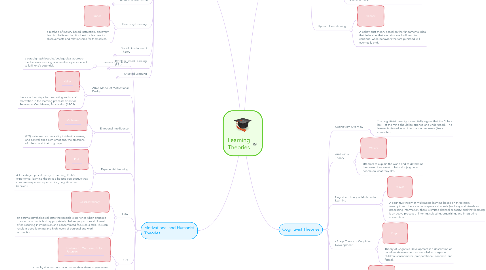
1. Constructivist Theories
1.1. Constructivism Overview
1.1.1. a paradigm or worldview posits that learning is an active, constructive process. The learner is an information constructor. People actively construct or create their own subjective representations of objective reality. New information is linked to prior knowledge, thus mental representations are subjective.
1.2. Anchored Instruction
1.2.1. Brandsford
1.2.2. involves the use of an “anchor” material or media, often a video, to create a shared experience among learners and a beginning pint for further learning on a topic.
1.3. Cognitive Apprenticeship
1.3.1. Collins et al.
1.3.2. theory that attempts to bring tacit processes out in the open. It assumes that people learn from one another, through observation, imitation and modeling.
1.4. Communities of Practice
1.4.1. Lave and Wenger
1.4.2. – “groups of people who share a concern or a passion for something they do and learn how to do it better as they interact regularly.” This learning that takes place is not necessarily intentional. Three components are required in order to be a (CoP) 10 the domain, 20 the community, and 3) the practice.
1.5. Connectivisim
1.6. Method of Instruction
1.6.1. Siemens, Downes
1.6.2. theory that explains how Internet technologies have created new opportunities for people to learn and share information across the World Wide Web and among themselves.
1.7. Discovery Learning
1.7.1. Bruner
1.7.2. a method of inquiry-based instruction, discovery learning believes that it is best for learners to discover facts and relationships for themselves.
1.8. Social Development Theory
1.8.1. Vygotsky
1.8.2. argues that social interaction precedes development; consciousness and cognition are the end product of socialization and social behavior.
1.9. Problem-Based Learning (PBL)
1.9.1. an instructional method of hands-on, active learning centered on the investigation and resolution of messy, real-world problems. Open ended problems, self-directed learners, teacher as facilitator, and student as problem solver.
1.10. Situated Learning
1.10.1. Lave
1.10.2. posits that learning in unintentional and situated within authentic activity, context, and culture.
2. Motivational and Humanist Theories
2.1. Humanism Overview
2.1.1. a paradigm/philosophy/pedagogical approach that believes learning is viewed as a personal act to fulfil one’s potential.
2.2. ARCS Model of Motivational Design
2.2.1. Keller
2.2.2. there are four steps for promoting and sustain motivation in the learning process; Attention, Relevance, Confidence, Satisfaction (ARCS).
2.3. Emotional Intelligence
2.3.1. Goleman
2.3.2. (EQ) is defined as the ability to identify, assess, and control one’s own emotions, the emotions of others, and that of groups.
2.4. Experiential Learning
2.4.1. Kolb
2.4.2. A four-stage cyclical theory of learning, Kolb’s experiential learning theory is a holistic perspective that combines experience perception, cognition, and behavior.
2.5. Flow
2.5.1. Csikszentmihalyi
2.5.2. an optimal psychological state that people experience when engaged in an activity that is both appropriately challenging to one’s skill level, often resulting in immersion and concentrated focus on a task. This can result in deep learning and high levels of personal and work satisfaction.
2.6. Grit
2.6.1. Duckworth, Matthews, Kelly, Peterson
2.6.2. a quality that learners have that enables them to persevere while facing struggles and obstacles. This can help the learners attain success because they don’t give up until they reach their goals.
2.7. - Intrinsically Motivated Instruction
2.7.1. Malone
2.7.2. takes place in computer gaming software when it provides players with choice around three key categories; challenge, curiosity, and fantasy.
2.8. - Maslow’s Hierarchy of Needs
2.8.1. Maslow
2.8.2. (often represented as a pyramid with five levels of needs) is a motivational theory in psychology that argues that while people aim to meet basic needs, they seek to meet successively higher needs in the form of a pyramid.
2.9. - Self-Determination Theory
2.9.1. Deci and Ryan
2.9.2. a theory of motivation and personality that addresses three universal, innate and psychological needs: competence, autonomy, and psychological relatedness.
3. Behaviorist Theories
3.1. Behaviorism Overview
3.1.1. Pavlov, Watson, Skinner
3.1.2. Behaviorism is a worldview that operates on a principle of “stimulus-response.” All behavior cause by external stimuli (operant conditioning). Behaviorism is a worldview that operates on a principle of “stimulus-response.” All behavior cause by external stimuli (operant conditioning).
3.2. Classical Conditioning
3.2.1. Pavlov, Watson
3.2.2. Classical conditioning is reflexive and requires a stimulus to evoke a response. (Pavlov- dogs, Watson-children)
3.3. GOMS Model
3.3.1. Card, Moran, and Newell
3.3.2. GOMS Model is a human information processing model that predicts what skilled users will do in seemingly unpredictable situations. (Goals, operators, methods, selection rules).
3.4. Operant Conditioning
3.4.1. Skinner
3.4.2. A behaviorist theory based on the fundamental idea that behaviors that are reinforced will tend to continue, while behaviors that are punished will eventually end.
4. Cognitivist Theories
4.1. Cognitivism Overview
4.1.1. The cognitivist paradigm essentially argues that the “black box” of the mind should be opened and understood. The learner is viewed as an information processor (like a computer)
4.2. Attribution Theory
4.2.1. Weiner
4.2.2. attempts to explain the world and to determine the cause of an event or behavior (e.g. why people do what they do).
4.3. Cognitive Theory of Multimedia Learning
4.3.1. Mayer
4.3.2. A cognitive theory of multimedia learning based on three main assumptions: there are two separate channels (auditory and visual) for processing information; there is limited channel capacity; and that learning is an active process of filtering, selecting, organizing, and integrating information.
4.4. - Stage Theory of Cognitive Development
4.4.1. Piaget
4.4.2. Theory of Cognitive Development is a description of cognitive development as four distinct stages in children; sensorimotor, preoperational, concrete, and formal.
4.5. - Cognitive Load Theory
4.5.1. Sweller
4.5.2. A theory that focuses the load on working memory during instruction.
4.6. - Gestalt Theory (
4.6.1. von Ehrenfels
4.6.2. – Learning takes place as students were able to comprehend a concept in it’s entirely, rather than broken up into parts.

